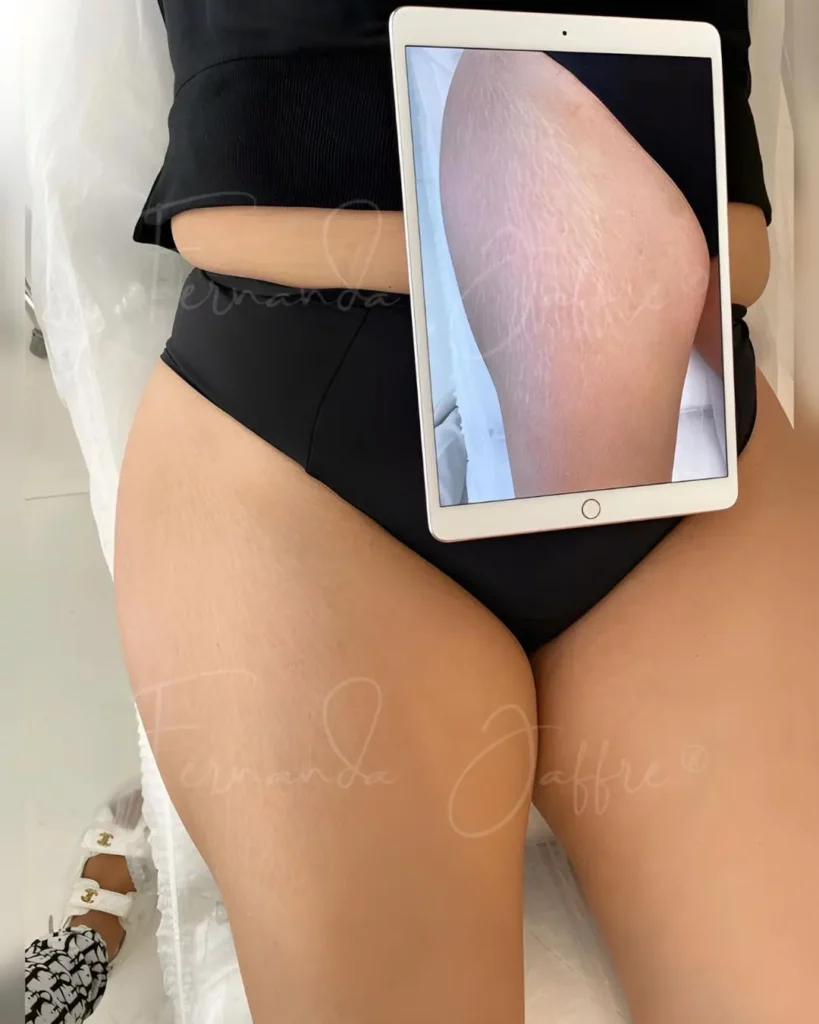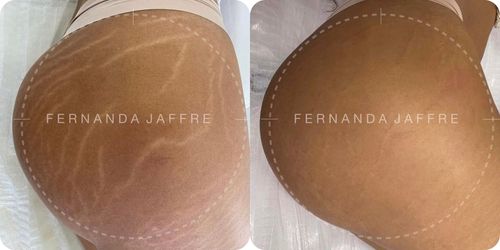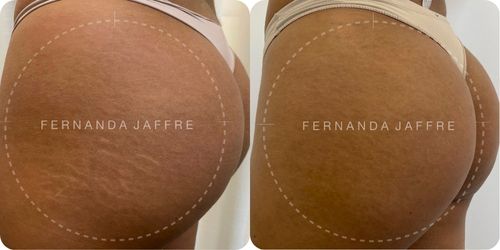
Stretch marks are a major worry for both women and men around the world. They can occur for a multitude of reasons, including development, puberty, and even special experiences such as your son’s birth.
For many years, individuals have sought a remedy for these types of marks, but one has yet to be identified, but the good news is that there is a way to have more beautiful skin.
This article will provide you all the information you need about this amazing technique, which has gained favor in the beauty business all around the world.
Read also:
Stretch mark camouflage, also known as skin camouflage tattoo or medical tattoo, aims to conceal/hide stretch marks with pigment, resulting in a more uniform and smooth appearance of the skin.
The camouflage tattoo technique involves applying specific pigments directly to the target affected areas.
These pigments are carefully picked to match the patient’s skin tone, resulting in a natural appearance.
During the procedure, a skilled specialist employs tattooing techniques to deposit pigments over the white lines of the stretch marks, giving the appearance of more homogeneous skin.
The end visual effect is a clear reduction in striae, which boosts confidence and contentment with physical appearance of the patient.
On average, 2 sessions are required to finish the work, however noticeable color changes may usually be observed after just one session.
Because it is a tattoo, the results might be deemed permanent. However, over time, the pigment on the skin may deteriorate, necessitating a touch-up treatment to preserve the flawless appearance and conceal any marks.
The longevity of the technique is contingent upon several factors, typically resulting in an average lifespan of 3 to 5 years.
Sun exposure is one of the most important elements, as the sun’s rays gradually lighten the ink.
So, here’s a tip: always apply sunscreen to the treated region. (after more information on when sunscreen can be used, see the section below on how to care after your treatment.)
Yes, you can. Stretchmark camo is a tattoo that behaves similarly. When done correctly, there will be no color differences. Your life will continue as usual, including exposure to sunlight!
You simply need to respect the healing period of your skin camouflage tattoo because it is critical to follow the specialist’s advice to achieve the greatest outcomes and avoid complications such as infections, inflammation, and premature fading of the pigment.
Fernanda Jaffre, a specialist, explains in this video what happens when a patient tans:
Watch the video about stretch marks tattoos and tanning.
The longevity of this work is proof that the technique works when done by a specialist.
Watch video before and after 5 years on the buttocks.
Fernanda Jaffre states, “Look, none of my clients have ever run away from my table! (laughs)”
Joking aside, Fernanda notes that there have never been any complaints about pain.
After all, most women seeking this treatment have already attempted hundreds of cosmetic procedures to remove stretch marks.
These treatments have often been ineffectual, and some have been exceedingly unpleasant.
Consequently, individuals do not feel pain following stretch mark tattoos.
Those who experience minor discomfort say it’s worth tolerating a little pain for a time to avoid worrying about the appearance of their striae.
The session typically lasts 2 hours. It is relatively quick, especially given the enormous change it brings to patients’ lives.
Camouflage healing times vary, but they often last 30 to 40 days.
The striae will be irritated for the first few days and may darken later; this is a fully normal physiological response to the needle trauma.
Over time, the region will brighten, revealing a more natural skin-tone.

All images © by Fernanda Jaffre

All images © by Fernanda Jaffre
Click here to learn more about stretch mark camouflage’s healing process.
No. Stretch marks that are red or purple (recent) are the result of inflammation and skin fiber rupture. Because they are recent, they can still be addressed using other healing approaches.
White (ancient) striae have already healed, thus other procedures are no longer helpful.
In this scenario, pigmentation using the camouflage approach is appropriate for giving the skin a more natural and delicate look.
Some scenarios necessitate more thorough assessment, but the most prevalent ones include:
Yes, there are numerous therapy options. As a result, it’s critical to determine if color or texture disturbs you more.
If it’s the hue, the only technique available right now is skin-color pigmentation. Aside from pigmentation, it can, as a secondary effect, promote collagen in the area, helping to improve texture.
Carboxytherapy, hyaluronic acid, glycolic acid, microneedling, micropuncture, electro-lifting, fractional CO2 laser, peels, radiofrequency, strong pulsed light, and other less effective procedures, like as creams, can all aid with texture.
As previously said, there are numerous solutions when texture is the primary concern, which can help to lessen the size of these marks, but keep in mind that these treatments do not change their color.
It is not recommended to employ micropigmentation for this purpose. Although they may appear similar, these techniques were designed for diverse goals, particularly in terms of the materials employed.
Micropigmentation is primarily performed with a dermograph, a pen-shaped equipment with extremely underpowered engine mechanics.
As a result, micropigmentation was designed for activities requiring ink to be deposited in the epidermis, the skin’s most superficial layer.
Striae, for example, occur on a person’s body, and if micropigmentation is used for this type of operation, the pen’s motor will most likely be overloaded, and the needle will be broken, perhaps resulting in skin injury due to incorrect equipment use.
Thus, micropigmentation is appropriate for activities such as lip pigmentation, scalp, brows, areolas, and even the hiding of dark circles.
It is impossible to conceal stretch marks without using ink. There is a method on the market known as inkless camouflage, however it is a marketing trick invented by opportunistic pros to gain customers.
So, what is the method? Microneedling is a well-known treatment that has been available for many years.
As previously said, microneedling is an effective method for improving the texture of markings because it stimulates collagen and elastin in the area.
Learn more about Inkless Tattoo Removal
Yes, indeed! Here are some pre-procedure tips to help you:
Healing may not go well on damaged skin. As a result, microneedling treatments, concentrated ultrasound, ultrasonic stretch marks, and any other therapy in the region that could cause skin harm should be avoided at all costs before your tattoo procedure.
First 3 days:
After 3 days:
Within the first 30 days:
Every aesthetic technique may include some level of risk. If you’ve ever had surgery, you know you’ve essentially signed your death warrant (laughter).
Jokes aside, the technique’s risks are minimal if the chosen specialist is skilled and confident in their abilities.
It may appear to be a simple task that anybody can complete, but in addition to experience in matching your skin tone through ink manipulation, they must also understand how to apply this pigment to the skin in accordance with its unique characteristics.
For example, in each body location, a different needle thickness should be used; for each mark, whether a stretch mark, scar, blemish, or vitiligo, the type of stroke, or rather, the operating approach, should change.



All images © by Fernanda Jaffre
Above all, this technique promotes a natural look. This means that concealed stretch marks should not look pigmented.
In other words, whether you’re at the beach, pool, wearing short or revealing clothing, or even intimate attire, those who look at you should not think you’ve “painted” them.
The ink should “blend in harmony” with the intact skin, resulting in a natural appearance that goes unnoticed by everyone who looks.








The cost varies according to the number of stretch marks each patient has and, most importantly, the chosen specialist.
The average procedure costs between $1,500.00 and $2,500.00. It is worth noting that this method has a durability of 3-5 years.
As a result, patients who receive this form of coverage are generally quite delighted with their investment.
After all, the majority of them have tried hundreds of approaches, none of which have worked.
The technique has evolved dramatically in recent years, prompting many people to enter the area with the sole goal of making money.
As a result, you may come across people who offer dermopigmentation procedures despite having no training.
In essence, these “professionals” looked for the lowest training accessible to perform a tattoo, which is a permanent treatment on your body.
This has left people, including yourself, feeling even more unsatisfied with camouflage techniques because, in many situations, the striae have become more visible.
Fernanda Jaffre says:
“I have worked tirelessly to achieve excellent results for my patients today.” I did this for two reasons: first, I wanted to make others feel better, and second, I felt empathy for them.
When I seek an aesthetic treatment for myself, I consider that I am ‘entrusting my body’ to this specialist, thus I demand nothing less than excellence.
After all, it’s my body, and I only get one.”
Stretch marks camouflage faults can be caused by a variety of circumstances.
Some cases come from inadequate patient care post-procedure, while the majority are caused by errors made by poorly qualified experts, such as:
Click here to learn why these errors arise.
The following video depicts a bad job because the professional made a mistake with the ink hue, making the patient’s stretch marks even more visible.
Yes, but removing unsuccessful camouflage is even more complicated than pigmentation itself. Furthermore, not every professional can remove camouflage; advanced understanding of removal techniques is required.
For example, the use of lasers may produce undesired outcomes. Laser use on a pigmented area can result in a variety of outcomes, the most severe of which is skin damage in the applied region.
This may cause burns, scars, or post-inflammatory hyperpigmentation on the skin.
As a result, the best line of action is to locate a professional in this approach.
They can safely remove the botched job or, in certain situations, fix it without having to remove the pigments, which would be far more complicated and time-consuming.
If you’re interested, click here to learn more about removal courses.
Also, read more about removal here.
Fernanda Jaffre is an internationally recognized dermopigmentation expert with almost 10 years of experience helping people all around the world enhance their self-esteem and quality of life.
She specializes in stretch mark concealing and scar cover-up techniques, having given the first scar tattoo camouflage training in the United States and Europe, and is responsible for popularizing this Brazilian technique around the world.
She is one of the few professionals in the market that is always improving her talents.
To contact Fernanda for a camouflaging consultation, go to the contact. To discover more about the specialty, please click here.
Fernanda Jaffre – From Brazil, world-renown Brazilian scar camouflage tattoo pioneer instructor.
All images © 2025 Fernanda Jaffre